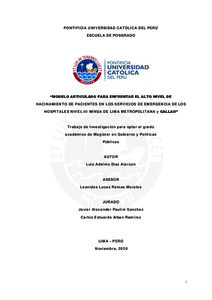| dc.contributor.advisor | Ramos Morales, Leónidas Lucas | |
| dc.contributor.author | Diaz Alarcon, Luis Adelmo | |
| dc.date.accessioned | 2021-08-06T00:35:43Z | |
| dc.date.available | 2021-08-06T00:35:43Z | |
| dc.date.created | 2020-11 | |
| dc.date.issued | 2021-08-05 | |
| dc.identifier.uri | http://hdl.handle.net/20.500.12404/19842 | |
| dc.description.abstract | En los últimos años, venimos siendo testigos de la sobredemanda de los
servicios de emergencia en hospitales de alta complejidad en la capital del país,
problema que es consecuencia de décadas de descuido y políticas de salud ineficientes
que no resuelven las necesidades de la población.
Pese a las iniciativas de mejora en el sector salud por parte del Estado, uno de
los problemas que prevalece es el hacinamiento en los servicios de emergencias,
principalmente evidenciado en los hospitales nivel III de Lima y Callao de acuerdo a la
percepción del personal de salud y de lo reportado por los medios de comunicación, lo
que marca un claro desequilibrio entre la oferta y demanda que enfrenta el sector salud.
Desde el Ministerio de Salud no se han realizado estudios técnicos que midan el
problema de hacinamiento en los servicios de emergencia de los hospitales nivel III de
Lima y Callao, excepto un reporte en el Hospital Rebagliati, en el cual el autor usa la
escala de NEDOCS obteniendo puntajes de 200, el nivel más alto de la escala,
correspondiente a la categoría de desastre, mayor a reportes internacionales, lo que
significa un elevado riesgo para el paciente y el personal de salud.
El presente proyecto de innovación realiza un análisis descriptivo y explicativo
del hacinamiento en los hospitales nivel III de Lima y Callao del Ministerio de Salud para
identificar las causas de este problema público y presentar una propuesta de solución
frente a la selección de una de las causas. El trabajo se divide en cuatro capítulos,
siendo estos: i) Descripción del problema, ii) Causas del problema, iii) Diseño del
prototipo y iv) Análisis de la deseabilidad, factibilidad y viabilidad del prototipo. | es_ES |
| dc.description.abstract | In recent years, we have been witnessing the over-demand for emergency
services in highly complex hospitals in the country's capital, a problem that is the
consequence of decades of neglect and inefficient health policies that do not meet the
needs of the population.
Despite the State's initiatives to improve the health sector, one of the problems
that continues to prevail is overcrowding in the emergency services. This can be
evidenced, mainly, in the Level III hospitals of Lima and Callao - according to the
perception of health personnel and what is reported by the media, which clearly marks
an imbalance between supply and demand that faces the health sector.
The Ministry of Health has not carried out technical studies that measure the
problem of overcrowding in the emergency services of the Level III hospitals of Lima and
Callao, except for a report carried out at the Rebagliati Hospital in which the author uses
the NEDOCS scale obtaining scores of 200, the highest level of the scale, corresponding
to the disaster category, higher than international reports. Which means a high risk for
the patient and the health personnel.
This innovation project carries out a descriptive and explanatory analysis of the
overcrowding in the level III hospitals of Lima and Callao of the Ministry of Health in order
to subsequently identify the causes of this public problem and present a solution proposal
against the selection of one of the causes. The work is divided into four chapters, these
being: i) description of the problem, ii) causes of the problem, iii) design of the prototype
and iv) analysis of the desirability, feasibility and viability of the prototype. | es_ES |
| dc.language.iso | spa | es_ES |
| dc.publisher | Pontificia Universidad Católica del Perú. | es_ES |
| dc.rights | info:eu-repo/semantics/openAccess | es_ES |
| dc.rights.uri | http://creativecommons.org/licenses/by-nc-nd/2.5/pe/ | * |
| dc.subject | Perú. Ministerio de Salud | es_ES |
| dc.subject | Hospitales--Servicios de urgencias--Perú--Lima Metropolitana | es_ES |
| dc.subject | Hospitales--Servicios de urgencias--Perú--Callao (Provincia Constitucional) | es_ES |
| dc.subject | Atención médica--Control de calidad--Perú--Lima Metropolitana | es_ES |
| dc.subject | Atención médica--Control de calidad--Perú--Callao (Provincia Constitucional) | es_ES |
| dc.title | Modelo articulado para enfrentar el alto nivel de hacinamiento de pacientes en los servicios de emergencia de los hospitales nivel III MINSA de Lima Metropolitana y Callao | es_ES |
| dc.type | info:eu-repo/semantics/masterThesis | es_ES |
| thesis.degree.name | Maestro en Gobierno y Políticas Públicas | es_ES |
| thesis.degree.level | Maestría | es_ES |
| thesis.degree.grantor | Pontificia Universidad Católica del Perú. Escuela de Posgrado. | es_ES |
| thesis.degree.discipline | Gobierno y Políticas Públicas | es_ES |
| renati.advisor.dni | 44385069 | |
| renati.advisor.orcid | https://orcid.org/0000-0001-9285-2953 | es_ES |
| renati.author.dni | 43452779 | |
| renati.discipline | 312048 | es_ES |
| renati.juror | Paulini Sanchez, Javier Alexander | |
| renati.juror | Alban Ramírez, Carlos Estuardo | |
| renati.juror | Ramos Morales, Leónidas Lucas | |
| renati.level | https://purl.org/pe-repo/renati/level#maestro | es_ES |
| renati.type | http://purl.org/pe-repo/renati/type#trabajoDeInvestigacion | es_ES |
| dc.publisher.country | PE | es_ES |
| dc.subject.ocde | http://purl.org/pe-repo/ocde/ford#5.06.00 | es_ES |






